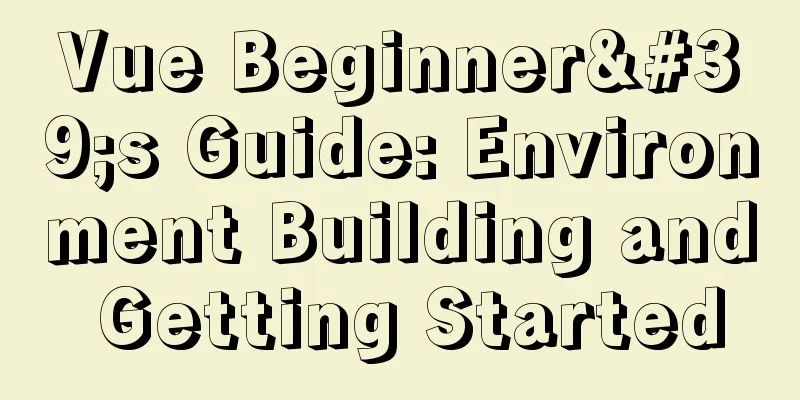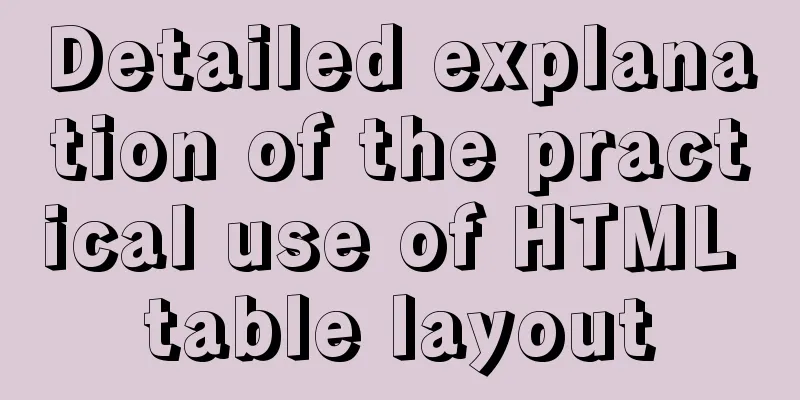Vue Beginner's Guide: Environment Building and Getting Started

|
Vue official website: https://cn.vuejs.org
Initial VueWhat is Vue? A progressive JavaScript framework for building user interfaces Vue can be applied layer by layer from bottom to top Simple applications: only a small and lightweight core library is needed Complex use: various Vue plug-ins can be introduced
Features of Vue: 1. Componentized mode to improve code reuse and better maintain code 2. Declarative coding: no need to directly operate DOM, improving development efficiency 3. Use virtual DOM + Diff algorithm to reuse DOM nodes Building a Vue development environment1. Download vue.js
2. Create a project and import idea
3. Download from the official website: https://github.com/vuejs/devtools/tree/main And use Vue.js devtools
Note: After this, if the web page you open is written in Vue, the Vue logo at the top will turn green. The above Vue environment is set up Creating a Vue Instance1. To make Vue work, you must create a Vue instance and pass in a configuration object 2. The code in the root container still complies with the HTML specification, but is mixed with some special Vue syntax 3. The code in the root container is called [Vue template] 4. Vue instances and containers correspond one to one 5. There is only one Vue instance in real development, and it will be used together with components 6 . The xxx in {xxx}} needs to be written as a js expression, and xxx can automatically read all the attributes in data. 7. Once the data in data changes, the place where the data is used in the page will also be automatically changed Pay attention to the difference between js expressions and js codes 1. Expression: An expression generates a value that can be placed anywhere a value is needed. (1)a (2)a+b (3)demo(1) (4)x===y?'a':'b' 2. js code (statement) (1)if(){} (2)for(){}
<html lang="en">
<head>
<meta charset="UTF-8">
<title>Initial Vue</title>
<!--Introduce Vue development version-->
<script type="text/javascript" src="../js/vue.js"></script>
</head>
<body>
<!--Prepare the container to provide a template for Vue to display the results of Vue-->
<div id="root">
<!--{{js expression}} interpolation syntax-->
<h1>Hello!{{name.toUpperCase()}},{{address}}</h1>
</div>
<script type="text/javascript">
Vue.config.productionTip=false //To prevent Vue from generating production tips at startup.
//Create a vue instance new Vue({
//el is used to determine which container the current Vue instance serves. The value is usually a css selector string el:'#root'.
//data is used to store data for use by the container specified by el, and the value is temporarily written as an object.
data:{
name:"The south wind knows my intention",
address:"Shanghai"
}
})
</script>
</body>
</html>
Running results:
Vue Template SyntaxThere are two main categories of Vue template syntax 1. Interpolation syntax: Function: used to parse the tag body content Writing method: {xxx}}, xxx is a js expression, and all attributes in data can be directly read 2. Command syntax: Function: used to parse tags (including tag attributes, tag body content, binding events...) For example: v-bind:href="xxx" or abbreviated as: href="xxx", xxx also needs to write a js expression and can directly read all the attributes in data Note: There are many instructions in Vue, and they are all in the form of: v-???. Here we just take v-bind as an example
<!--Prepare the container-->
<div id="root">
<h1>Interpolation Syntax</h1>
<h3>Hello, {{name}}</h3>
<hr/>
<h1>Command Syntax</h1>
<!--Bind url as expression-->
<a v-bind:href="school.url.toUpperCase()" x="hello">Go to {{school.name}}</a>
<a :href="url" x="hello">Go to {{name2}}</a>
</div>
</body>
<script type="text/javascript">
Vue.config.productionTip=false //To prevent Vue from generating production tips at startup.
new Vue({
el:'#root',
data:{
name:'Southern Wind Knows My Intentions',
school:
name: 'csdn',
url:'https://blog.csdn.net/weixin_50823456?spm=1000.2115.3001.5343',
}
}
})
</script>
Running results:
Vue Data BindingThere are two ways of data binding in Vue: 1. One-way binding (v-bind): data can only flow to the page 2. Two-way binding (v-model): Data can flow not only from data to page but also from page to data Remark: 1. Two-way binding is generally applied to form elements (such as: input, select, etc.) 2. v-model:value can be abbreviated as v-model, because the default collection of v-model is value value
<!--Prepare a container-->
<div id="root">
<!--Normal writing-->
<!-- One-way data binding: <input type="text" v-bind:value="name"><br>
Two-way data binding: <input type="text" v-model:value="name"><br>-->
<!--Abbreviation-->
One-way data binding: <input type="text" :value="name"><br>
Two-way data binding: <input type="text" v-model="name"><br>
<!--The following code is wrong: v-model can only be applied to form elements (input elements)-->
<h2 v-model:x="name">Hello</h2>
</div>
</body>
<script type="text/javascript">
Vue.config.productionTip=false
new Vue({
el:'#root',
data:{
name:'The South Wind Knows My Intentions'
}
})
</script>
Running results:
Two ways to write el-dataTwo ways to write data and el 1. There are two ways to write el (1)Configure el attributes when creating new Vue (2) Create a Vue instance first, then specify the value of el through vm.$mount('#root') 2. There are two ways to write data (1) Object-oriented (2) Functional How to choose: Currently, any writing method is fine. When learning components in the future, data must be written in a functional way, otherwise an error will be reported. 3. An important principle For functions managed by Vue, you must not write arrow functions. Once you write an arrow function, this is no longer a Vue instance.
<!--Prepare the container-->
<div id="root">
<h1>Hello, {{name}}</h1>
</div>
</body>
<script type="text/javascript">
Vue.config.productionTip=false
//Two ways to write el const v=new Vue({
//el:'#root', //The first way to write data:{
name:'Shang Silicon Valley'
}
})
console.log(v)
v.$mount('#root') //The second way of writing //Two ways of writing data const v=new Vue({
el:'#root',
//The first way to write data is object-style /*data:{
name:'Shang Silicon Valley'
}*/
//The second way to write data: functional data(){
console.log('@@@',this) //This is the Vue instance object return{
name:'The South Wind Knows My Intentions'
}
}
})
</script>
MVVM Model1. M: Model: data in data 2. V: View: Template code 3. VM: View Model: Vue instance Observations: 1. All attributes in data finally appear in vm 2. All properties of vm and all properties of Vue prototype can be used directly in Vue template
<!--Prepare the container-->
<div id="root">
<!--view-->
<h1>School name:{{name}}</h1>
<h1>School address:{{address}}</h1>
</div>
</body>
<script type="text/javascript">
Vue.config.productionTip=false
const vm = new Vue({ //viewmodel
el:'#root',
data:{
/*model*/
name:'South Wind',
address:'Changsha'
}
})
console.log(vm)
</script>
Vue Data ProxyOperation (read, write) of properties in another object through an object proxy 1. Data proxy in Vue: Use the vm object to proxy the operation (read and write) of the attributes in the data object 2. Benefits of Data Proxy in Vue More convenient operation of data in data 3. Basic principles Add all the properties in the data object to vm through Object.defineProperty() Assign a getter and setter to each property added to the vm Operate (read, write) the corresponding attributes in data inside getter and setter
<!--Prepare the container-->
<div id="root">
<!--view-->
<h1>School name:{{name}}</h1>
<h1>School address:{{address}}</h1>
</div>
</body>
<script type="text/javascript">
Vue.config.productionTip=false //Prevent Vue from generating production tips at startup const vm=new Vue({
el:'#root',
data:{
name:'South Wind',
address:'Changsha'
}
})
</script>
Event handling in VueBasic usage of events: 1. Use v-on:xxx or @xxx to bind events where xxx is the event name 2. The event callback needs to be configured in the methods object and will eventually be on the vm 3. The function configured in methods does not require an arrow function, otherwise this will not be vm 4. The functions configured in methods are all functions managed by Vue, and this points to vm or component instance object 5. @click="demo" and @click="demo($event)" have the same effect, but the latter can pass parameters
<!--Prepare the container-->
<div id="root">
<h1>Welcome to Shang Silicon Valley to study</h1>
<!--<button v-on:click="showInfo">Click me for information</button>-->
<button @click="showInfo1">Click me for info 1</button>
<button @click="showInfo2(66,$event)">Click me for info 2</button>
</div>
</body>
<script type="text/javascript">
Vue.config.productionTip=false //Prevent Vue from generating production tips at startup new Vue({
el:'#root',
data: {
name: 'Shang Silicon Valley'
},
methods:{
showInfo1(event){
/* console.log(event.target.innerHTML)
console.log(this) //This is vm*/
alert("Hello classmate 1")
},
showInfo2(number,a){
/* console.log(event.target.innerHTML)
console.log(this) //This is vm*/
alert("Hello classmate 2")
console.log(number,a)
}
}
})
</script>
SummarizeThis is the end of this article about Vue's Beginner's Guide to Environment Setup and Getting Started. For more relevant Vue environment setup and getting started content, please search 123WORDPRESS.COM's previous articles or continue to browse the following related articles. I hope everyone will support 123WORDPRESS.COM in the future! You may also be interested in:
|
>>: nginx+tomcat example of accessing the project through the domain name
Recommend
Example code for implementing a circular trajectory animation using CSS3 and table tags
html: In fact, it is to arrange several solid cir...
Implementation of MySQL Shell import_table data import
Table of contents 1. Introduction to import_table...
Improving the effect of hyperlinks in web design and production
Hyperlinks enable people to jump instantly from pa...
CSS naming conventions (rules) worth collecting Commonly used CSS naming rules
CSS naming conventions (rules) Commonly used CSS ...
ul list tag design web page multi-column layout
I suddenly thought of this method when I was writi...
Detailed explanation of installing and completely uninstalling mysql with apt-get under Ubuntu
1. Install mysql: udo apt-get install mysql-serve...
Detailed explanation of Vue monitoring attribute graphic example
Table of contents What is the listener property? ...
How to convert rows to columns in MySQL
MySQL row to column operation The so-called row-t...
A brief discussion of several browser compatibility issues encountered
background Solving browser compatibility issues i...
In-depth explanation of currying of JS functions
Table of contents 1. Supplementary knowledge poin...
How to modify mysql permissions to allow hosts to access
Enable remote access rights for mysql By default,...
Detailed explanation of JavaScript to monitor route changes
Table of contents history pushState() Method push...
Configuring MySQL and Squel Pro on Mac
In response to the popularity of nodejs, we have ...
Several commonly used single-page application website sharing
CSS3Please Take a look at this website yourself, ...
Complete step-by-step record of MySQL 8.0.26 installation and uninstallation
Table of contents Preface 1. Installation 1. Down...


















